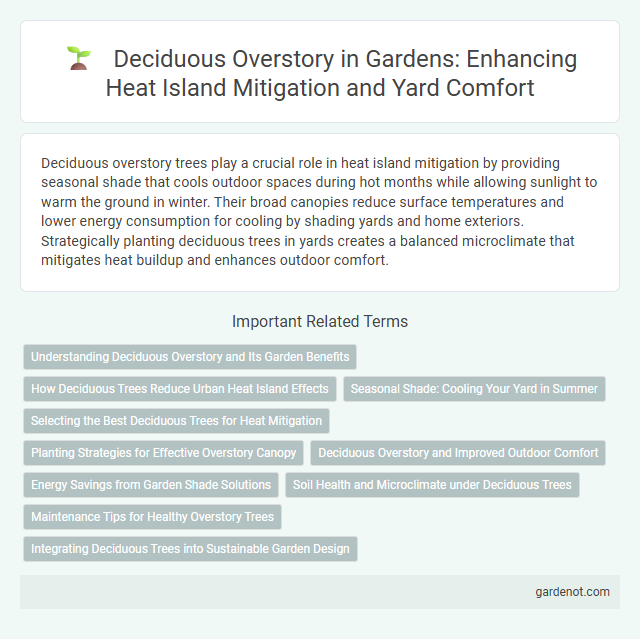Deciduous overstory trees play a crucial role in heat island mitigation by providing seasonal shade that cools outdoor spaces during hot months while allowing sunlight to warm the ground in winter. Their broad canopies reduce surface temperatures and lower energy consumption for cooling by shading yards and home exteriors. Strategically planting deciduous trees in yards creates a balanced microclimate that mitigates heat buildup and enhances outdoor comfort.
Understanding Deciduous Overstory and Its Garden Benefits
Deciduous overstory trees play a critical role in heat island mitigation by providing seasonal shade that lowers surface temperatures during summer while allowing sunlight to warm the ground in winter. These trees enhance garden microclimates by reducing heat stress on plants and improving soil moisture retention through leaf litter decomposition. Their strategic placement in yards supports energy savings, improved air quality, and increased biodiversity, making them essential for sustainable landscape design.
How Deciduous Trees Reduce Urban Heat Island Effects
Deciduous trees significantly reduce urban heat island effects by providing extensive canopy cover that blocks solar radiation during hot months, thereby lowering surface and air temperatures. Their seasonal leaf shedding enhances winter solar access, maximizing energy efficiency in surrounding buildings. These trees also improve evapotranspiration rates, which cool the environment through moisture release and contribute to improved urban microclimates.
Seasonal Shade: Cooling Your Yard in Summer
Deciduous overstory trees provide dense, seasonal shade that significantly reduces yard temperatures during the summer months, mitigating urban heat island effects. Their broad canopies intercept sunlight, lowering surface and air temperatures beneath, and decreasing the need for artificial cooling. In fall, their leaf drop allows sunlight to warm the area, balancing seasonal comfort and energy efficiency.
Selecting the Best Deciduous Trees for Heat Mitigation
Choosing the best deciduous trees for heat island mitigation involves prioritizing species with broad, dense canopies that provide ample shade during hot months while allowing sunlight in winter. Trees like silver maple (Acer saccharinum), red oak (Quercus rubra), and sugar maple (Acer saccharum) are effective due to their rapid growth and large leaf area index which reduces surface temperatures by shading pavements and buildings. These trees also improve air quality and evapotranspiration, contributing to localized cooling and lowering urban heat island effects in residential and commercial yards.
Planting Strategies for Effective Overstory Canopy
Strategic planting of deciduous overstory trees maximizes shade coverage during summer, reducing urban heat island effects by lowering surface and air temperatures. Optimizing tree species selection based on canopy density and growth rate ensures effective seasonal shading and energy savings. Proper spacing and orientation enhance airflow and sunlight penetration, promoting a balanced microclimate in heat island mitigation yards.
Deciduous Overstory and Improved Outdoor Comfort
Deciduous overstory trees provide significant heat island mitigation by offering seasonal shading that reduces surface and air temperatures during summer months, while allowing sunlight penetration in winter for natural warming. Their broad canopies and strategic placement enhance outdoor comfort by decreasing UV exposure and lowering heat stress in urban yards. This dynamic shading effect contributes to improved microclimates and energy savings in surrounding buildings.
Energy Savings from Garden Shade Solutions
Deciduous overstory trees provide significant energy savings by shading buildings during hot months, reducing cooling costs by up to 30%. Their seasonal leaf drop allows sunlight to penetrate in winter, enhancing passive solar heating and lowering heating expenses. Effective garden shade solutions using deciduous trees contribute to sustainable heat island mitigation by moderating outdoor and indoor temperatures year-round.
Soil Health and Microclimate under Deciduous Trees
Deciduous overstory trees significantly enhance soil health by increasing organic matter through leaf litter decomposition, which enriches nutrient cycling and improves soil microbial activity. Their seasonal canopy regulation creates a favorable microclimate beneath the tree, reducing soil temperatures in summer and allowing sunlight penetration in winter, promoting diverse understory vegetation. This dynamic microclimate supports moisture retention and reduces urban heat island effects, contributing to overall yard heat island mitigation strategies.
Maintenance Tips for Healthy Overstory Trees
Pruning deciduous overstory trees during late winter promotes robust growth and prevents structural damage by removing dead or diseased branches. Regularly inspecting for pests and diseases helps maintain tree vitality and reduces vulnerability to stress factors common in urban heat island environments. Maintaining proper soil moisture and applying mulch conserves water, enhances root health, and improves tree resilience against extreme heat conditions.
Integrating Deciduous Trees into Sustainable Garden Design
Incorporating deciduous overstory trees into sustainable garden design effectively reduces urban heat island effects by providing seasonal shade and promoting natural cooling. Their broad, dense canopies block solar radiation in summer while allowing sunlight to warm the ground in winter, optimizing energy efficiency for surrounding structures. Selecting native deciduous species enhances biodiversity, improves soil health, and contributes to long-term ecological balance in heat island mitigation efforts.
Deciduous overstory Infographic

 gardenot.com
gardenot.com